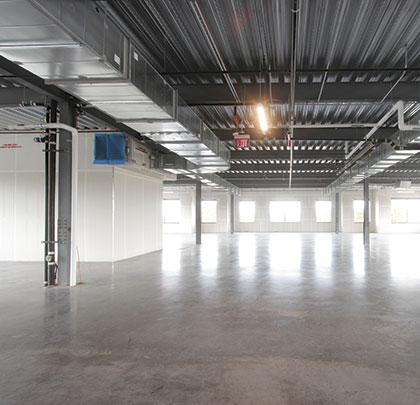Concrete has vastly become one of the most popular flooring options within facilities today. Whether used as a subfloor or top layer, it can provide facilities with an extremely durable and long lasting application when tested and installed correctly. Part of that process requires testing your slab for moisture content and vapor emissions prior to the installation of any products. Moisture can cause adhesive failures, promote mold and mildew growth and, in time, result in product delamination, curling or, bubbling.
Product and installation warranties require minimal moisture content, contamination, and emission levels to be maintained before, during, and after installation. If these conditions aren’t met, warranties can be voided. Therefore, it is imperative to correct moisture issues early to ensure successful installation and maximum long-term flooring value.
CONCRETE SLAB READINESS
How do you know your concrete slab is ready to receive floor covering? The universally recognized testing methods for moisture are ASTM F1869 for calcium chloride and ASTM F2170 for relative humidity. These tests measure the moisture emitted and contained within the concrete slab. These tests last between 60-72 hours and require the environment to remain at 75 degrees F (± 10 degrees F) with a relative humidity of 50 percent (± 10 percent) for 48 hours prior to and during the test.
It’s essential to have a fully functioning HVAC system in order for the required environmental conditions to be met before, during, and after the test. In addition to testing for moisture, the surface of your concrete must be pH tested for alkaline salts, which can be brought to the surface of the slab by moisture vapor and lead to flooring adhesive failures.
MOISTURE TRANSMISSION
How does moisture transmission occur? There are a number of reasons, but the most common include:
- Inadequate water drain off from the building—moisture travels from the outside, into and up through the concrete capillaries and through the flooring system inside.
- Ground water seeping in from underneath the concrete slab.
- Rain or rewetting of the slab before the building is enclosed.
- Improperly installed vapor barrier—the vapor barrier must be installed correctly and be free of holes in order to prevent any vapor from coming up from the ground and through the concrete slab.
Another common cause of moisture transmission is a lack of sufficient drying time after your concrete is poured. When the concrete is curing, it takes time for moisture to escape, but construction time constraints and deadlines can leave concrete without adequate drying time. Even pan-poured, upper-level floors can create moisture problems if sufficient curing time isn’t allotted. Normal conditions require 120 to 180 days.
PREVENTING MOISTURE
How can you prevent these problems? You may never be able to completely prevent moisture problems, but you can minimize them. There are five steps in controlling moisture.
- Install a quality vapor barrier, making sure there are no holes or cracks.
- Use a low water/cement ratio.
- After the concrete has set, scarify the surface of the concrete to obtain a good bond with flooring adhesives.
- Avoid rewetting of the slab.
- Have a fully functioning and operating HVAC system to meet the required environmental conditions.
As you can see, it is crucial to evaluate and address moisture issues in your concrete, as they will affect your floor coverings for years to come. By doing so, you will enjoy a better, longer-lasting flooring that provides maximum value over the life of your facility.
About the Author:
Mitchell Bryant is the communications specialist at Spectra Contract Flooring, the largest commercial flooring contractor in the U.S. For more, visit www.spectracf.com.
_________________________________________________________________________
Modern Contractor Solutions, January 2018
Did you enjoy this article?
Subscribe to the FREE Digital Edition of Modern Contractor Solutions magazine.



